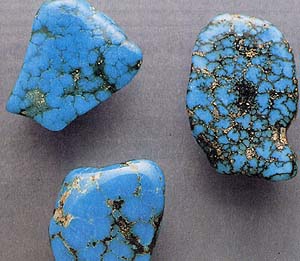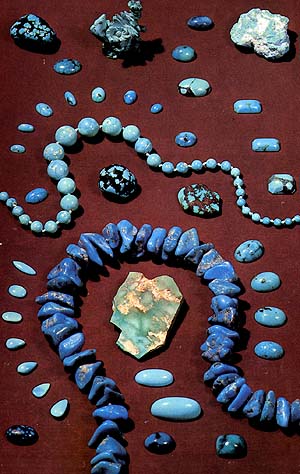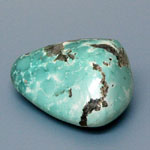Phosphates: Turquoise
 Diagnostic Card.
Diagnostic Card.
6 Cu Al (PO 4)4 (OH) 8 * 4 H 2 O
Crystal system triclinic
Hardness 5-6
The proportion of 2.6-2.8
Cleavage imperfect
fracture conchoidal
Colour greenish-blue
Color powder blue and white
Gloss of wax to pearl
The word "turquoise" comes from the Persian word - "Pirouz", "Firuza" - victory, a winner. Synonym "Callan" (in Greek. Beautiful stone) is less well known. The crystals: fine, very rare; usually grozdevidnye and kidney-shaped aggregates, thin veins. The crystals were first discovered in Virginia (USA) in 1911, before the mineral is considered amorphous. On the fresh fracture gloss glass or wax.
A beautiful sky-blue color gives way at 250 o C tatty green (requires caution when soldering products!). Colouring port also under the influence of sunlight, cosmetics, sweat and oil (turquoise rings when washing hands is better to remove!), As well as at high dry air. Polishing enhances coloration. Impregnation in oil or paraffin bath treatment or special plastics contribute to an increase in mineral hardness due to clogged pores. Pure blue color is rare, usually turquoise riddled with brown (limonite) or black (psilomelane) veins: the so-called "turquoise matrix" or "net turquoise". There are also fusion turquoise with malachite and chrysocolla.
Turquoise is found in the form of dense masses of performing cracks and grozdevidnyh and nodular segregations, raids and nodules. Turquoise veins reach a power of 2 cm best quality turquoise deposits are known in the north-eastern Iran (near Nishapur - Persian turquoise).. There are deposits in Afghanistan, Eastern Australia, China (Tibet), Israel (north of Eilat), Tanzania, to the southwestern United States and in the CIS (Central Asia, Caucasus).
 Chemical composition unstable. In the aging process and the replacement part is amplified secondary minerals iron oxide, silica, calcium, magnesium, zinc, and strontium. Chemical composition (%): CuO - 9. 57, Al2O3 - 36,84, Pb2O3 - 34,12, H2O - 19,47. Unavoidable impurities - sulfur, zinc, barium, chromium, nickel, titanium and others.
Chemical composition unstable. In the aging process and the replacement part is amplified secondary minerals iron oxide, silica, calcium, magnesium, zinc, and strontium. Chemical composition (%): CuO - 9. 57, Al2O3 - 36,84, Pb2O3 - 34,12, H2O - 19,47. Unavoidable impurities - sulfur, zinc, barium, chromium, nickel, titanium and others.
Usual weight of microcrystalline kidney-shaped or in the form of crusts, veinlets and irregular-shaped clusters. Hardness is reduced to 2-4 at the weathered samples, fragile. In dense copies, 2.6 g / cc. in weathered. Turquoise is often found in the form of rounded nodules - nodules.
Dispersion: strong. Blue turquoise color is characteristic of the unaffected by weathering of turquoise depends on the copper content. Greenish, brownish, and other tones due ferric iron substituting copper in a zone of intense its expansion. Impurities halloysite, kaolinite and vavellita give whitish spots. Turquoise Often contains inclusions of quartz, pyrite and other minerals.
Always opaque, translucent sometimes only at the edges, it has a uniform blue color. But the most common species found branching brown or black limonite veining. Transparent crystals are rare cases. Almost always, turquoise occurs as rounded nodules or massive clusters microcrystalline structure and kidney-shaped; can form in the veins of the country rocks. Due to its porosity turquoise readily undergoes secondary changes, change its natural color. So sometimes you have to handle it with special protective switching means.
Diagnostic features.
When heated in a glass tube turquoise loses water and becomes brown or black. In addition, it does not melt in the flame of a candle flame and does not stain in green that sets it apart from counterfeits. In the Middle Ages Persian merchants transporting turquoise water in jugs.
mineral porosity allows it artificially tint aniline dyes, and copper salts. Simulates turquoise using colored chalcedony, govlita, turquoise chips, "sintered" with an adhesive mass, as well as glass, porcelain or synthetic resins. Synthetic fake found on the market under the names of jewels "Hamburg turquoise," "Neolithic" and "neobiryuza". Turquoise can be confused with amatriksom, amazonite, chrysocolla, hemimorphite, lazulitom, odontolitom, serpentine, smithsonite, varistsitom.
Origin.
Turquoise - a mineral of secondary origin. It is formed by saline solution circulation in the thickness of the sedimentary rocks, mainly sandstone or volcanic rocks (trachyte) typically highly fractured.
Place of Birth.
The classical field of turquoise, known since antiquity - Ali Mirza Kuh near Nishapur (Iran). Found also in Sinai, in Kazakhstan and Uzbekistan. Beautiful color for concretions found in the states of Nevada, New Mexico and Arizona. Rare clear crystals came from Virginia, from Belgium and from the peninsula of Cornwall. Turquoise developments on the Sinai Peninsula are the most ancient of the existing mines. Turquoise mining began there in 6000 BC. e. Deposits of turquoise in the Sinai peninsula has been developed for the 4th millennium BC. e. While made of turquoise amulets, jewelry, used it in cosmetics.
The use in jewelry.
Turquoise is used in jewelry and for making statues and intaglios. Turquoise is one of those gems that are often counterfeited, replacing both natural and artificial materials.



- Gatchell - "New Almadén snag" - arsenide and antimony sulfide (modern sulphosalts)
- Antimony - toxic metal (semi-metal) are widely used in industry, medicine and engineering
- Zirconium - a rare and non- metal and dangerous jewel in the oxide and salts
- Gold - yellow dangerous and toxic metal -date and accurate digital cable technology
- Sulphur - a golden-yellow toxic substance and a sign of volcanic activity
- Cadmium - a toxic uncirculated unknown wide range of people silvery metal
- Lead - a poisonous gray simulator silver metal and toxic metal snag
- Arsenic - poison classic medieval and modern poisoners and medicine in medicine
Toxic and hazardous radioactive rocks and minerals
** - Poisonous stones and minerals (obligatory check in chemical laboratory + clear indication of toxicity)
** - Radioactive rocks and minerals (obligatory check on a regular dosimeter + ban on the open sale of radioactivity in the event of more than 24 mR / hour + additional measures to protect the population)
Catalog minerals and gems in groups of the world
** - Poisonous stones and minerals
** - Radioactive rocks and minerals


Comments
Commenting, keep in mind that the content and the tone of your messages can hurt the feelings of real people, show respect and tolerance to his interlocutors, even if you do not share their opinion, your behavior in terms of freedom of speech and anonymity offered by the Internet, is changing not only virtual, but real world. All comments are hidden from the index, spam control.